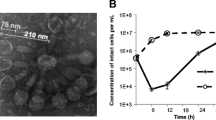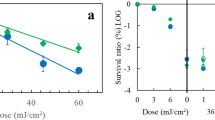Abstract
Escherichia coli K-12 transformed with pACYC184 plasmid DNA was exposed to ozone (O3) in aqueous solution. The damage to the membrane, protein, plasmid DNA, and cell survival were investigated. Cell viability was unaffected by short-term O3 exposure (1–5 min) but membrane permeability was compromised as indicated by protein and nucleic acid leakage and lipid oxidation. The intracellular components, protein and DNA, remained intact. With longer durations of O3 exposure (up to 30 min) cell viability decreased with a more significant increase in lipid oxidation and protein and nucleic acid leakage. The proteins leaking out were further oxidized by O3. The total intracellular proteins run on sodium dodecyl sulfate/polyacrylamide gel electrophoresis, and plasmid DNA run on agarose gel, showed progressive degradation corresponding to the decrease in cell viability. The data indicate that membrane components are the primary targets of O3 damage with subsequent reactions involving the intracellular components, protein and DNA.
Similar content being viewed by others
Author information
Authors and Affiliations
Additional information
Received: 18 Apirl 1996 / Received revision: 26 July 1996 / Accepted: 5 August 1996
Rights and permissions
About this article
Cite this article
Komanapalli, I., Lau, B. Ozone-induced damage of Escherichia coli K-12 . Appl Microbiol Biotechnol 46, 610–614 (1996). https://doi.org/10.1007/s002530050869
Issue Date:
DOI: https://doi.org/10.1007/s002530050869




